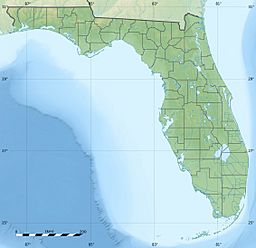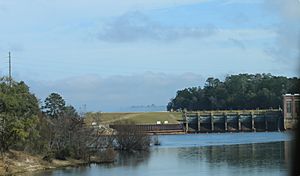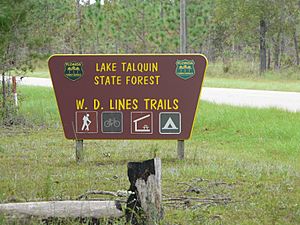Lake Talquin facts for kids
Quick facts for kids Lake Talquin |
|
|---|---|
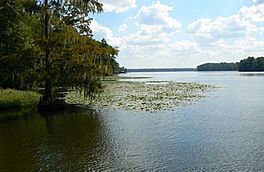
viewed from Wallwood Scout Camp on the north shore, looking to the northeast (October 2007)
|
|
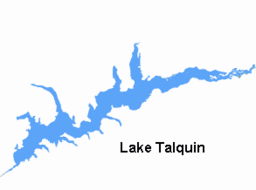
outline
|
|
| Location | Gadsden / Leon counties, Florida, United States |
| Coordinates | 30°23′19″N 84°38′48″W / 30.38861°N 84.64667°W |
| Type | reservoir |
| Primary inflows | Ochlockonee River |
| Primary outflows | Ochlockonee River |
| Basin countries | United States |
Lake Talquin is a large reservoir (a human-made lake) located in northern Florida. It sits on the Ochlockonee River, between Leon County and Gadsden County. The lake is about 10 miles (15 km) west of Tallahassee.
The name Talquin comes from combining parts of the names of two nearby cities: Tallahassee and Quincy. The lake was created to generate hydroelectric power, which is electricity made using the force of moving water.
Lake Talquin State Forest covers many areas of land along the lake's edges. This forest helps protect the natural beauty and wildlife around the lake.
Contents
How Lake Talquin Was Made
Lake Talquin was formed in 1927 when the Jackson Bluff Dam was built. This dam was constructed on the Ochlockonee River. Its main purpose was to produce hydroelectric power.
The dam is an earthen dam, meaning it's made mostly of soil and rock. It stands about 60 feet tall. The Jackson Bluff Dam is special because it is one of only two hydroelectric power plants in Florida.
For many years, a company called Florida Power operated the dam. In 1970, they gave about 30,000 acres of land and lake bottom to the State of Florida. This land became part of what is now Lake Talquin State Park. The City of Tallahassee later took over running the dam to generate electricity. However, in 2017, Tallahassee decided to focus more on solar power instead of hydroelectricity.
What Lake Talquin Looks Like
Lake Talquin is surrounded by rolling hills and deep valleys. The water level usually stays around 70 feet above sea level. However, it can change by up to 3 feet depending on the season.
The lake covers about 10,000 acres, which is roughly 15 square miles. Its shoreline stretches for more than 40 miles. If you count all the small coves and inlets, the shoreline is even longer! Most of the land along the shore is public, so it remains natural and undeveloped.
Most of Lake Talquin is about 1 mile wide. The total length of the lake is nearly 20 miles. The eastern part of the lake is only 11 miles from downtown Tallahassee. Even so, the lake's shores are very natural and peaceful.
Much of the lake's edge is now part of Lake Talquin State Forest. The water in the lake is shallow in most places, except along the old river channel. You might see many dead trees and stumps sticking out of the water. These are reminders of the forest that was there before the lake was created. These stumps can sometimes make boating tricky, especially on the eastern side of the lake.
Animals and Plants of Lake Talquin
The forests around Lake Talquin are home to many different animals. You can spot Eastern gray squirrels and fox squirrels. Wild turkeys, bald eagles, and ospreys also live here.
Keep an eye out for alligators and whitetail deer. Other common sights include egrets, blue herons, and various kinds of water turtles. You might also see water snakes, like water moccasins. During summer, insects like mosquitoes and chiggers can be quite plentiful.
The area's forests are made up of different types of trees. You'll find pine trees and hardwood trees. These hardwoods include sweetgum and many kinds of oak trees.
Fun Things to Do at Lake Talquin
Lake Talquin State Forest covers a lot of the southern and southwestern parts of the lake. There are many places to launch boats and enjoy a picnic. One popular spot is the Rock Bluff Recreation Area in Leon County. These areas are great for private picnics, parties, family gatherings, and even weddings.
The lake is also used by the Florida State University Crew Club. This is a rowing club where students practice and compete.
Fishing at Lake Talquin
Lake Talquin is a popular spot for fishing. The lake is home to many types of fish. You can catch largemouth bass and striped bass. Other fish found here include crappie, bream, pickerel (also called "jack"), gar, catfish, and bowfin.
Images for kids


